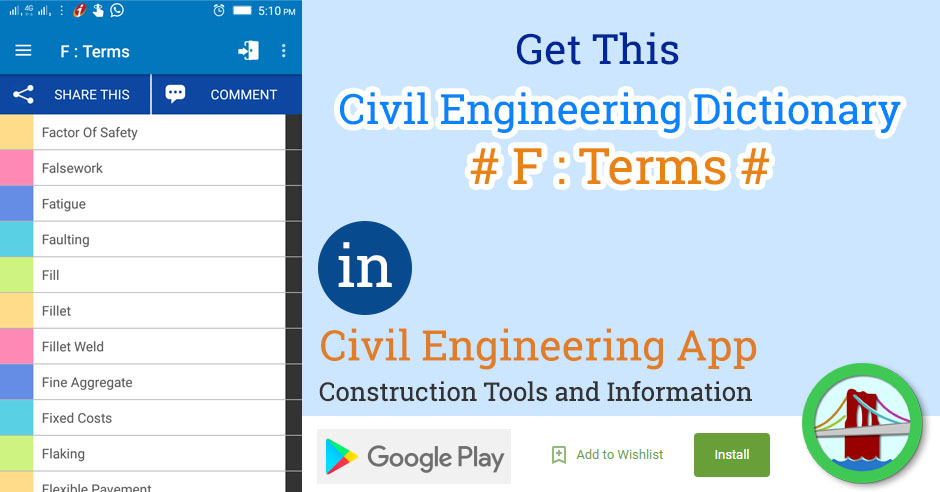A | B | C | D | E | F | G | H | I | J | K | L | M | N | O | P | Q | R | S | T | U | V | W | X | Y | Z
| Sr. | Term | Definition |
| 1 | Factor Of Safety | The stress at which failure is expected, divided by the design stress (maximum permissible stress). |
| 2 | Falsework | Support for concrete formwork or for an arch during construction. |
| 3 | Fatigue | The lowering of the breaking-load of a member by repeated reversals of stress so that the member fails at a much lower stress than it can withstand under static loading. |
| 4 | Faulting | The difference in elevation of two adjacent concrete slabs at a joint, primarily caused by the traffic-induced movement of base material particles from under one joint edge to under the adjacent joint edge. |
| 5 | Fill | Earthwork in embankment or backfilling. |
| 6 | Fillet | 3 to 6 inches wide shamfer for column to add beauty and strength by avoiding sharp angels. |
| 7 | Fillet Weld | A weld of roughly triangular cross-section between two pieces at right angles. |
| 8 | Fine Aggregate | (1) Sand or grit for concrete which passes the No. 4 sieve (4.76 mm) and retained in the No. 200 sieve (74 micron or 0.074 mm). (2) Sand or grit for bituminous road-making which passes a sieve of 3 mm square opening. |
| 9 | Fixed Costs | Any necessary labor, material and equipment costs, directly expended on the item or items under consideration which remain constant regardless of the quantity of the work done. |
| 10 | Flaking | Peeling off of the coating. |
| 11 | Flexible Pavement | An asphaltic pavement structure having sufficiently low bending resistance to maintain intimate contact with the underlying structure, yet having the required stability furnished by aggregate interlock, internal friction between particles and cohesion to support traffic. |
| 12 | Flexure | Word meaning bending. |
| 13 | Flume | A wooden, steel or concrete open channel to carry or measure water flows. |
| 14 | Fly-Ash | The ash which goes to the chimney from pulverized coal and is caught in the fluegas dust extractors. It is used as pozzolan or as an admixture to cement. |
| 15 | Force | That which tends to accelerate a body or change its movement (i.g., the weight of a body is a force which tends to move it downwards). |
| 16 | Formation Level | The surface level or elevation of the ground surface after all digging and filling, but before concreting. |
| 17 | Formwork | The wood molds used to hold concrete during the placement and curing processes. |
| 18 | Foundation Failure | Foundations of buildings can fail in one of two ways, first by differential settlement, secondly by shear failure of the soil. |
| 19 | Freeway | A divided arterial highway with full control of access. |
| 20 | Frictional Soil | A clean silt, sand or gravel that is a soil whose shearing strength is mainly decided by the friction between particles. In Coulomb’s equation, sand shear strength is given by the statement S = P tan O, since sand has no cohesion. |
| 21 | Frontage Road | A local street or road auxiliary to, and located on the side of an arterial highway for service to an abutting property and adjacent areas, and for control of access. |
| 22 | Frost | Weather during which dew is deposited as ice. The danger to construction caused by frost is that water expands by about 9% of its volume when it freezes. Therefore concrete or mortar which have not set and contain free water are disintegrated by it. |
| 23 | Fusion Welding | The welding of metals or plastics by any method which involves melting of the edges of the parts to be joined without pressure. Usually a filler rod provides the weld metal. |
A | B | C | D | E | F | G | H | I | J | K | L | M | N | O | P | Q | R | S | T | U | V | W | X | Y | Z

